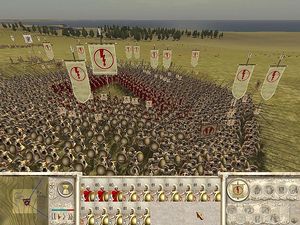Turtling
Turtling can refer to a tactic or campaign strategy that emphasizes heavy defense. Both definitions involve a player hoarding resources and building up heavy defenses early on in the game, while refusing to risk moving and/or exposing his or her weak spots. This typically involves minimizing losses a là attrition and baiting opponents to attempt an attack.
The term turtling is derived from the protective shell of a turtle and the reluctancy of the turtle to emerge from that shell.
Contents
As a Battle Tactic
Turtling as a battle tactic emphasizes the defense to the point where the turtling player neglects building up forces to attack the enemy, and typically refuses moving his or her forces from deployment.
Details
Turtling originally emerged in strategy games as an easy-to-learn battle tactic for new players, as it did not require good reflexes or reaction time, unlike rush tactics. Not only that, but army choice also influenced how turtling developed and spread. In the Total War series, the prevalence of heavy , defense-oriented units, such as pikemen, and the addition of defense-oriented special abilities, notably the phalanx and the schiltrom drove the development of turtle strategies as a whole.
The release of Medieval II: Total War Kingdoms in 2007 coincided with the release of pop culture hit 300, as did the peak of Rome: Total War multiplayer activity, and as a consequence, new, inexperienced players toyed with the turtle strategy to mimick a famous battle scene in 300. Players chose all-pike or spearmen armies, and arranged them so that they faced in all directions; the turtling player then refused to move and the resulting tactic became known amongst inexperienced players as "Playing 300" and among experienced players as a "noob box". See Formations for more on this subject.
History in Total War
Turtling has taken place in every Total War game to date, but it perhaps only came to prominence with Rome: Total War's debut in 2004. The addition of the phalanx formation, explained to be nearly invulnerable from frontal attack, may have been misleading in that the phalanx formation actually had many weaknesses (See Formations for more). Neither the tutorial nor the ingame advisor could explain that, even if placed in a formation protecting all sides, the loss of tactical mobility could cripple team games and allow flanking with superior missile units.
Stake Boxes
"Stakes are probably one of the most inefficiently used weapons by new players." -User Yellowmelon, at the Guild
A stake box is a defensive box formed by placing archers' stakes around one's army to defend from all flanks. This is not a good strategy, because contrary to what it might seem, these boxes, like other turtle strategies, endanger teammates and actually allow flanking to be easier. The placement of ranged units in these boxes means that opponents can destroy such forces by deploying more archers in a missile war. This is because only a select number of archers can face front at a time, and any who venture outside of the box may be quickly routed by light cavalry or mobile infantry contingents.
As a Campaign Strategy
Turtling as a campaign strategy relies on typical human behavior to avoid risks if they perceive such risks to not be worth the outcome. As such, turtling involves building up large stacks of units in a compacted area to discourage opponents from attacking, allowing the turtling player to build up resources and advance technology without running the risk of being attacked.
Details
To turtle, a player will simply accumulate armies in one place without attacking other players. As the game progresses, the turtle becomes stronger but other players will not risk attacking in fear of getting weak for no benefit. The turtle exploits the selfishness of other players to its advantage until it is powerful enough to start taking them out one by one.

